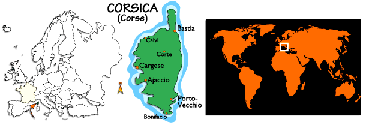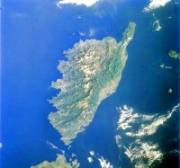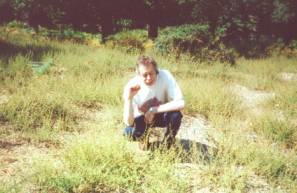|
|
|
|
Corsica:Aromatic Journey Notes. |
By Tony Burfield April 2001 |
|
|
|
|
Corsica:Aromatic Journey Notes. |
By Tony Burfield April 2001 |
This is a collection of notes about the amazing herb-strewn island of Corsica, where much of the island is protected parkland and the traveller is quickly immersed in waist-high wild aromatic plants in any direction!

Corsica is the 4th largest island in the Mediterranean with an area of 3352 square miles and has been described as "a mountain range jutting out into the sea".

NASA photo of Corsica
The Corsican experience includes an overwhelming aromatic subjection: odour pervades the air in so many locations throughout the spring and long summer, suffocating the senses. Corsica has an interesting variety of plant forms (2835 species) since it offers a range of diverse climates, ranging from thermal Mediterranean to alpine (up to 2700m) - often within the persistence of snow above 2000 m. There is also a diversity of soil types from granite (covering most of the island, to alluvial plain and some calcareous outcrops. One third of the population are employed in agriculture growing citrus fruits, olives and chestnuts as well as soft fruits like apples, cherries and plums in the East and vine cultivation for wine.
Of direct interest to aroma-heads of the littoral (i.e. seashore) area of Corsica are marked with plants like Crithmum maritinum and Rosemarinus officinalis. (Crithmum maritimum here has an amazing citrus-lemon scent when picked: so is possibly the para-cymene chemotype rather than the common phenol ether types!). It is the densely vegetated marquis - an area of shore, which is a collective place for a group of plants with fragrant properties covering 40% of the island - which is particularly famous in Corsica and other areas of the Mediterranean. To describe the odour of the marquis can be difficult: conditions can vary according to location and time of year. (For a more scientific description see R. Kaiser "The Ligurian coast" Perf. & Flav. Vol 22, Mar/April p7-18). In spring the air can be quite floral with the odour of yellow Calcitone willosa flowers, but to many the odour of the marquis is typified by the cistes group from which the smell of labdanum and resin abound. As well as the cistes, broom, lonciera, myrtle, arbutus and lentisque, Lavender stoechas and Rosemary are also found. Surprisingly found in areas at first glance which do not seem excessively damp, are Mentha rotundifolia, are M. sauveolens (2 subspp here), and other mints.
Helichrysms are represented by the alpine Helichrysum frigidum whilst on the shoreline the halophilic (i.e. salt-loving) H. italicum var. microphyllum abounds. Helichrysum flowers smell fresh turpentine-like with a slight hint of coffee (some say curry-like), but it is interesting to note how the odour changes on aging. Dried flower heads by comparison take on the smell of oxidised terpenes but with lemon note, but the dried leaves have a more dried-tea odour with a liquorice effect. All this is useful background for what happens in practice in distillation. But, that's another story.

Smelling Calamint in Corsica
Calamintha nepeta subsp. glandulosa with its white to mauve flowers and intense minty odour is also very common and scents the air strongly. It is widely used as a culinary herb in Corsican cuisine. I have literally come across acres of this plant growing near woodland: quite a sight! Artemisias seem to be common, some as garden escapes I think, but I did find the rarer Artemisia carelescens subsp. gallica var. densiflora. In the town markets can be found great tubs of seeds from the marquis: Rosemary, Thymus serpyllum, Dill, Fennel, as well as packets of herbs, although you have to be careful: on inspection some of these products appear to be packed in Provence France!
Inland Nepeta agrestis (Corsican catnip) is found in massive proportions on wasteland. The intense minty odour pervades the air and suffuses the senses. Interestingly nepetalactone occurring in many Nepeta spp. has now been found effective as a deterrent against roaches and other insects (New Scientist 28 Aug 1999 p22). If this property were ever properly exploited commercially, Corsica would probably have a lot to offer in this direction (if N. agrestis was found to contain this in quantity).
Corsica is well known for the oil of Inula graveolens. Other scented Inulas are present: Inula crithmoides is found extensively on the island as well as "les inules visqueux" (Dittrichia viscosa) with its scented odour and "les Inules odourant" Pulicaria odorata. I note that Pulicaria gnaphnoides, amongst other oils, was investigated by P. Weyerstahl in a recent article ("Isolation, Synthesis and Olfactory Properties of New Compounds from Essential Oils" p78 from "Recent Developments in Flavour & Fragrance Chemistry Proc of 3rd Int H&R Symposium" Ed R. Hopp & K. Mori pub VCH 1993).
Thymes are found at elevation: Thymus herba-barona is recognized by the local people as having at least 3 chemotypes: a citronellol-like variant, a linalol-like variant and a thymol-like variant. Again they are much used in culinary cuisine.
Eucalyptus globulus was introduced into Corsica in 1865 by Dr. R. Carlotti to dry up some of the swampy areas, but can now be found lining the entrance roads to many small towns and villages. It was a thrill for me to see the fruits of Eucalyptus and to experience their intense Blackcurrant-leaf like odour, which fills the rooms of a house if brought indoors. The odour is reminiscent of thiomenthone but fresher (maybe more like thiocineol?). The blackcurrant note can be detected clearly in Eucalyptus resinoids and absolutes, items which are sometimes used in perfumery.
There are many trees that now grow to 100m. in height. Mimosa (Acacia dealbata) was also introduced into Corsica and is found everywhere and the yellow flowers sent the air in Jan/Feb months. The Strawberry tree Arbutus unedo is no stranger to the UK but is also extensively found in Corsica. The red-yellow goose-bumped fruits are treated to remove calcium oxalate and oxalic acid and then turned into fruit jelly or distilled for an eau-de-vie. The taste of the jam is mild & sweet, with a syrup-like aftertaste. The strong antibiotic properties of this species have been put to use in folk medicine to treat diarrhea and biliousness. The large fruits of Juniperus oxycedrus L. macrocarpa and Junpierus phoenicea (subsp. mediterannea) which is a thermophilic ecotype- and Juniperus thrucifera also abound on the island.
The bark of Pistachia lenticus is excised to prepare mastic, an oloeresin used in perfumery and flavours. Local uses for the berries included using them to fragrance rooms with their aromatic odour. Mastic oil has a green note can have amazing galbanum-like quality: something I hadn't really appreciated before until I saw the "real thing". Myrtle berries are extensively used in leather tanning and fish/meat preservation, but Myrtle jam and Myrtle liqueurs are widely available in local shops. The taste is distinctly blackcurrant-like.
Finally, many essential oils are offered from Corsica by small distillers: for some of these the output is in kilos per annum, or even fractions of a kilo per annum! Amongst those that can be found for sale are the much sought-after Helichrysum italicum and Inula graveolens, but also Pinus nigra subsp. laricio (a nice clean pine), an interesting Lavandula stoechas, a very fresh cineolic Laurus nobilis, and others such as Myrtus communis, Rosemarinus officinalis, Eucalyptus globulus, Eucalyptus camaldulensis, Lippia citriodora, Cupressus sempervirens, Juniperus communis and many other organic types. Corsica truly has a great deal to offer!
Copyright © 2000-2001
by Tony Burfield AIA UK
All Rights Reserved